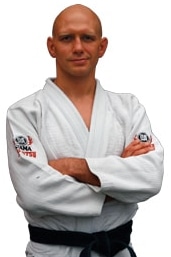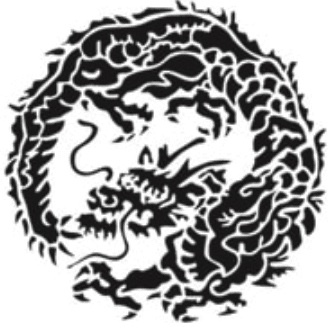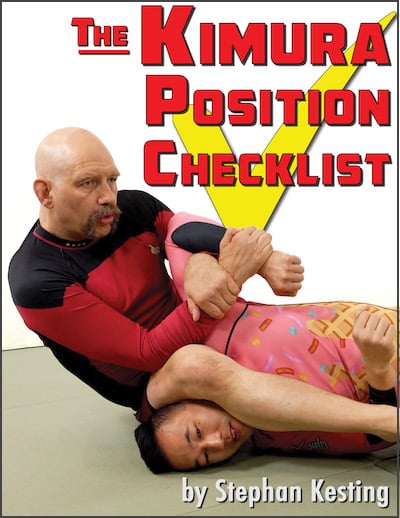
Being on someone’s back is one of the most dominant positions in all of jiu-jitsu. This is for good reasons: all his weapons are facing away from you, he can’t see what you’re doing, and you’re only half a second away from finishing him with the rear naked choke.
One submission you’re seeing more and more from the back is the triangle choke with the legs. This is showing up all over the place, and especially in no gi grappling.
(That triangle choke is actually two different triangle chokes, but more on that later.)
The triangle finish from the back usually starts with the Kimura control, so let’s take a second to explain what that is and why it’s important.
When you’re on your opponent’s back, he’s going to be SUPER motivated to escape, and one of the most reliable escapes is for him to get his head to the mat, and then slither backwards using the ground to scrape you off of him (here’s that escape in the gi but it works almost the same in no gi).
Here’s where the Kimura grip – a figure 4 grip where one of your hands controls his wrist and your other hand holds your own wrist – comes in.
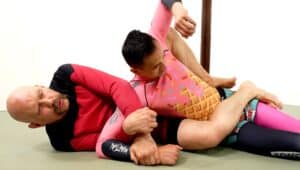
This Kimura grip creates a frame where your upper arm and elbow elevate your opponent’s head. His head is blocked from going to the floor by your arm, and thus he cannot start his escape.
To make the Kimura control from the back more powerful, adjust your legs so that your bottom calf forms a “lap belt” across his waist. This leaves your top leg free to entangle his top arm, which sets up many of your most effective submissions. Trapping his arm doesn’t require as much flexibility as you’d think; the key is shrimping backwards to escape your hips up towards his shoulders.
Now let’s talk triangle chokes. There are actually two different triangle chokes that you’ll commonly use from the back.
The heuristic to decide which triangle to use is that you’re always locking your legs on the uphill side of his body initially. Let me show you what I mean….
Triangle 1: Legs Triangled Under the Armpit
Let’s say that we start in the Kimura-control postion shown above, but your opponent rolls from his right side onto his left side. Since it’s hard to adjust your legs on the downhills side underneath his body you decide to triangle your legs on the ‘uphill’ side, his right.
Because you have control of his arm you will usually end up triangling your legs underneath his armpit, as in the photo below. My left instep is going behind my right knee. My left calf presses into one side of his neck, and his own right deltoid is pushing into the other.
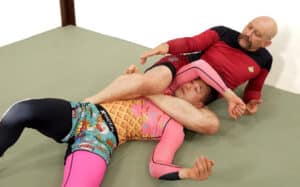
There’s a pretentious trend sweeping through jiu-jitsu of giving techniques names from Japanese Judo, so this move is called Ura Sangaku Jime. There you go – I’ve done my duty!
From this choking position you can finish your opponent a number of ways, including by angling your legs to form a ‘V’ around his neck, pushing his head down into your shin, applying a straight armlock, a modified Americana armlock, or a kneebar-stretch. All of these are covered in the video at the top of the page.
Triangle 2: Legs Triangled Over the Shoulder
If you’ve got Kimura control on your opponent’s right arm and he stays on his right side then it’s difficult to configure your legs as you did above; the ground is in the way.
His left shoulder is now the uphill shoulder instead of his right, and that means you’ll triangle your right foot behind your left knee just above his left shoulder.
The pressure on his neck is very similar to the first triangle, except my right Achilles tendon is now cutting into the far side of his neck instead of my left calf.

In the picture above you can see that if Michael continued to turn into me he’d end up in the standard triangle choke from guard (Hon Sangaku Jime for you vocabulary nerds).
The pressure into the side of the neck is just awful, but if he still doesn’t tap then you can switch to a very powerful armbar by controlling his wrist and bridging, either maintaining the triangle position or stepping over the head.
The Importance of the Kimura
The importance of mastering the Kimura control from the back can’t be overstated.
You can’t just be on your opponent’s back and throw your legs up hoping to catch one of these triangle chokes. Having his arm tied up and vastly reducing his escape options is the secret sauce that makes these attacks work.
To help you with that here are two resources I would like you to consider…
The first, is The Kimura Roadmap, my latest full-length instructional that delves deep into the positional game behind the Kimura.
Here’s a trailer for the instructional, and if any of it resonates then click here to find out more about The Kimura Roadmap.
Secondly, I’ve put together a 15 page PDF breaking down the main Kimura positions and how they all connect together.
Click here to download the 15 page PDF for free.
Good luck with your training! Go triangle choke someone and let me know about it on the socials.
Stephan Kesting

